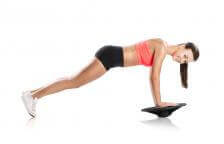3 Ways to Get Better Balance
Bad balance can throw you off your game, while good balance can improve your body’s performance and fitness levels. Get-Fit Guy has 3 ways to get better balance.

Or, think about playing your favorite sport – such as golf, tennis, basketball, soccer, gymnastics, or whatever else you love to do. Do you find yourself occasionally wobbly, feeling less-than-stellar balance, or not being able to aim hit, catch, or throw accurately?
All of these described are problems with balance – a notoriously neglected aspect of fitness. So in today’s episode, you’re going to learn 3 keys ways to get better balance so that you look better, perform better, and move more gracefully.
Sponsor: CreditSignal from Dun & Bradstreet Credibility Corp. Gain control of your business credit with Credit Signal. Sign up for your Free CreditSignal here.
What Is Balance?
You can simply think of balance as your ability to maintain your base of support with minimal postural sway or collapse. In physics, something called a “line of gravity” is used to define balance. Specifically, better balance would involve an increased ability to maintain your line of gravity over your base of support.
But in more basic Get-Fit Guy terms, balance is simply the ability to move your body and limbs around efficiently, precisely, and quickly while also being able to change direction without falling down.
Technically, maintaining balance requires coordination of 3 different sensory systems in your body:
- The vestibular system, which consists of the sense organs in your head (primarily your ears) which regulate your equilibrium and give your brain directional information related to your head position.
- The somatosensory system, which relies on nerves called “propriocepters” in your joints, along with the pressure and vibration sensors in your skin and your joints.
- The visual system, which relies on your eyes to figure out where your head and body are in space, and also your location in space relative to other objects.
For you to be properly balanced, each of these components must be optimized. In other words, you need to have good eyes, good ears, and healthy joints. Here’s how….
3 Ways to Get Better Balance
Now that you understand each of the different body systems necessary for optimal balance, it’s time for some quick and dirty tips that enhance each of these 3 components:
Tip #1: For Better Vestibular Balance, You Should…
- Avoid loud music, loud sounds, and cell phone radiation near your head.
- Go unshod as much as possible, or use minimalist footwear.
- Balance on one leg while keeping your gaze on something stationary, then eventually train yourself look at objects farther away, then progress to closing your eyes completely, and finally add an unstable surface to the mix.

- Practice standing one legged or two legged on unstable surfaces such as wobble boards, thick balance mats, or balance disc pillows.
- Do side or front leg kicks with a band or a cable, while standing without arm support on the opposite foot.
- Do double and single leg exercises on a mini-trampoline or vibration platform.
- Stand on one leg at elevation, such as on a stair, park bench, or step platform. Elevated surfaces send an instant cue to your brain that you’re in danger, and can upregulate quality and frequency of proprioceptive cues.
Tip #3: For Better Visual Balance, You Should…
- Avoid long periods of time staring at computer screens without breaks, or wear blue light-blocking “gamer” glasses if you have lots of planned or required screen time.
- Use apps like Awareness, WorkRave, Time Out, and ProtectYourVision that remind you to briefly stop working, or to focus your vision elsewhere.
- Play a sport that requires eye tracking, such as soccer, golf, tennis, basketball, or even ping-pong.
- Sleep 7-8 hours per night, which allows your visual system to relax and relieve eye strain.
- Try the Bates Method, a series of eye exercises designed to strengthen the muscles in the eye but also to strengthen the mental connection between the brain and the eye.
Once you begin taking care of your vestibular, somatosensory, and visual systems, you’re going to find that movement such as running becomes far less awkward. As a bonus, you’ll also find that you may get better at sports and move more gracefully. Your body will be more tuned for getting fit faster!
If you have more questions about ways to get better balance, then join the conversation at Facebook.com/GetFitGuy!
Athlete balancing and push-up images courtesy of Shutterstock.






